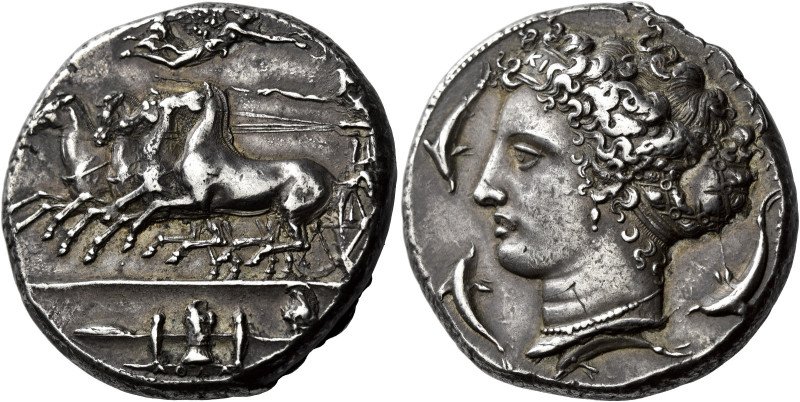
Syracuse Decadrachm
Syracuse Decadrachm: A Masterpiece by Kimon (Circa 405-400 BC)
Overview
The Syracuse decadrachm, created circa 405-400 BC, is a masterpiece of ancient Greek numismatic art. Signed by the renowned engraver Kimon, this silver coin (AR) measures 32 mm in diameter and weighs 43.16 g. Its intricate design, historical significance, and exceptional craftsmanship make it a coveted collector’s item.
Obverse: Dynamic Quadriga and Victory
The obverse features a dynamic quadriga (four-horse chariot) driven to the left by a female charioteer. She leans forward, holding a kentron in her right hand and reins in her left, emphasizing the chariot’s speed and intensity. Above, Nike, the goddess of victory, flies rightward to crown the charioteer with a laurel wreath.
Beneath the exergual line, there’s a display of military armor arranged on two steps, including:
- A shield and crested helmet
- A cuirass between greaves
The inscription “[AΘΛA]” identifies the display as athla, or prizes, hinting at a connection to the Olympic games or Syracuse’s military triumphs.
Reverse: Portrait of Arethusa
The reverse showcases the head of the nymph Arethusa, a central figure in Syracusan mythology. She is depicted in left profile, adorned with:
- An intricate earring with a lotus blossom pendant
- A beaded necklace
- Hair bound in a net with a headband inscribed “ΚΙ”
Surrounding Arethusa are four dolphins, symbolizing her association with the sea. One dolphin touches the truncation of her neck, adding depth to the design. This side of the coin is celebrated as a masterpiece of classical Greek art, with Arethusa’s serene expression and elaborate details exemplifying Kimon’s genius.
Signature of Kimon: A Mark of Excellence
The coin bears Kimon’s signature in three places:
- “ΚΙ” on Arethusa’s headband
- “KIMΩN” on the dolphin beneath her neck
- Miniature letters on the exergual line of the obverse
These signatures highlight Kimon’s pride in his work and mark this coin as one of his finest creations.
Historical Context
The decadrachm was minted during a transformative period in Syracuse’s history, coinciding with the city’s victory over Athens during the Peloponnesian War (431-404 BC).
In 415 BC, the Athenians launched a naval expedition to Sicily, aiming to conquer Syracuse and control its grain supply. After a prolonged siege, Syracuse achieved a decisive victory in 413 BC, capturing Athenian ships and enslaving their soldiers. The influx of silver from plunder and slave sales enabled Syracuse to mint an extraordinary new coinage, reflecting its wealth and artistic renaissance.
Artistic and Cultural Significance
The decadrachm exemplifies the golden age of Syracusan coinage, often referred to as the “age of signing artists.” This era saw engravers like Kimon pushing the boundaries of artistic expression, creating coins that were not only currency but also works of art.
- The quadriga scene on the obverse symbolizes both athletic prowess and military success, possibly serving as an allegory for Syracuse’s triumph over Athens.
- The reverse portrait of Arethusa is a paradigm of classical beauty, with every detail—from her earring to her flowing hair—crafted with meticulous precision.
Provenance and Rarity
This particular decadrachm has an illustrious provenance, having passed through notable collections and auctions:
- Florange & Ciani, February 1925
- Nomos Sale 10, 2015
- NAC 96, America Collection, 2016
It also originates from the famous Noto (Falconera) Hoard of 1908 (IGCH 2103), further adding to its historical allure. Coins of this quality and condition are exceedingly rare, making them highly desirable among collectors.
Conclusion
The Syracuse decadrachm by Kimon is a testament to the artistic and cultural achievements of ancient Greece. Its dynamic design, historical resonance, and exceptional craftsmanship make it a symbol of Syracuse’s power and artistic ingenuity during the late fifth century BC. For collectors and enthusiasts, it represents a pinnacle of Greek numismatic art and an enduring legacy of Kimon’s unparalleled talent.
Leave a Reply